Abu Bakr al-Baghdadi (1971-26 October 2019), born Ibrahim Awad Ibrahim Ali al-Badri al-Samarrai, was an Iraqi Islamist imam and Emir of the Islamic State of Iraq from 18 April 2010 to 7 April 2013 (succeeding Abu Omar al-Baghdadi) and Caliph of the Islamic State from 7 April 2013 to 26 October 2019 (preceding Abu Ibrahim al-Hashimi al-Qurashi). He oversaw the transformation of the Iraqi insurgent group into a multinational menace with a worldwide reach (with affiliate groups in 18 countries), and, amid the Iraqi Civil War and the Syrian Civil War, the Islamic State occupied a vast swathe of territory in Iraq and Syria which included 18 million people. al-Baghdadi established Raqqa as capital of the Islamic State and brutally enforced Wahhabist sharia law, and he claimed to be Caliph, leader of the Islamic world; however, his claim was rejected not only by the countries of the world, but also by other extreme Islamist groups such as al-Qaeda. al-Baghdadi was a mysterious and elusive figure, rarely making public appearances; he was reported dead or injured many times before being killed in a Delta Force raid on Barisha, Syria on 26 October 2019.
Biography[]
Early life[]
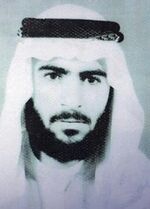
A young Baghdadi
Ibrahim Awad Ibrahim Ali al-Badri al-Samarrai was born in Samarra, Iraq in 1971, the third of four sons born to a Sunni Arab family; one of his brothers was killed in action while serving in the Iraqi Army during the Iran-Iraq War or Gulf War, while his brother Juma would later serve as his bodyguard.
His father Sheikh Awwad, who was active in the local community's religious life, educated al-Badri, who came to lead children in a neighborhood chanting the Quran. His nearsightedness led to his exemption from the draft during the Gulf War in 1991, and he went on to study sharia at the Islamic University of Baghdad; he later received a doctorate in Islamic studies from Saddam University. While a university student, he was recruited into the fundamentalist Muslim Brotherhood.
Following his graduation, he lived in a room attached to a small local mosque in the poor Tobchi neighborhood of Baghdad, and, while he led prayer at the mosque, he was quiet and unimpressive.
Iraq War[]
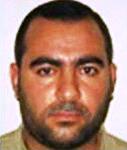
Baghdadi in 2004
al-Badri was a mosque cleric at the time of the United States-led invasion of Iraq in 2003, and he founded an Islamist revolutionary group in opposition to the US forces and became the head of its sharia committee. On 4 February 2004, he was arrested by US forces while visiting one of his fugitive former classmates, but he was released on 8 December 2004 as a "low-level" civilian detainee. In 2006, his group merged into the Mujahideen Shura Council, and al-Badri became the head of the MSC sharia committee as well; he remained an insurgent commander as the MSC transformed into al-Qaeda in Iraq and AQI into the Islamic State of Iraq.
Emir of ISI[]
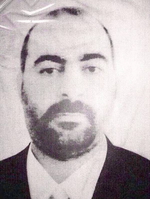
An earlier photo of Abu Dua
On 16 May 2010, following the death of the ISI leader Abu Omar al-Baghdadi, al-Badri became the new Emir of the Islamic State of Iraq, and he assumed the nom de guerre "Abu Dua". From March to April 2011, ISI carried out 23 terrorist attacks south of Baghdad, with Abu Dua masterminding them. On 5 May 2011, he masterminded an attack on Hillah which killed 24 policemen and wounded 72 others in a revenge attack for Osama Bin Laden's assassination. In August 2011, a wave of ISI suicide bombings in Mosul killed 70 people, and, on 22 December 2011, just days after the US withdrawal from Iraq, a wave of bombings in Baghdad killed over 63 and wounded over 180.
Formation of ISIS[]
On 8 April 2013, Abu Dua announced the creation of the "Islamic State of Iraq and Syria", which absorbed several al-Qaeda units fighting in the Syrian Civil War. However, a large faction of the al-Qaeda-affiliated al-Nusra Front rejected the merger, leading to infighting between ISIS and al-Nusra. al-Qaeda emir Ayman al-Zawahiri attempted to mediate the dispute and asked that Abu Dua confine his activities to Iraq, but Abu Dua refused and absorbed 80% of al-Nusra Front's foreign fighters while also taking over the city of Raqqa from them in January 2014 and making it ISIS' base in Syria. In February 2014, al-Qaeda cut its ties with ISIS in response to Abu Dua's rebellion. Abu Dua launched recruiting drives in Saudi Arabia and received funds from private donors in Saudi Arabia and Qatar, and the revitalized ISIS launched a massive offensive in Iraq which overwhelmed Anbar Governorate and much of northern and western Iraq, threatening the capital of Baghdad.
Rise of the Caliphate[]
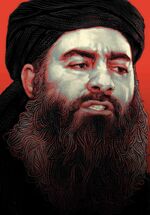
A TIME Magazine portrait of Baghdadi in 2015
With the recently-captured city of Mosul as his base of operations in Iraq, Abu Dua, now known as "Abu Bakr al-Baghdadi" was made "Caliph Ibrahim" of the Islamic State on 29 June 2014, claiming that IS would establish a worldwide caliphate. al-Baghdadi was a descendant of Muhammad, as his al-Badri clan was related to the Quraysh tribe, and he assumed his nom de guerre "Abu Bakr" in honor of the first caliph, Abu Bakr. He encouraged Muslims from around the world to emigrate to the caliphate and called on his followers to march on Rome and Spain, declaring war on the West. al-Baghdadi and his caliphate became notorious for beheading Western journalists and other hostages, committing genocide against Assyrians, Kurds, Yazidis, and other minority groups, and destroying ancient Mesopotamian, Assyrian, Roman, and Christian cultural heritage sites. In addition, IS strictly enforced sharia law by stoning "infidels" to death, massacring prisoners-of-war in a variety of cruel methods, throwing homosexuals from rooftops, and banning cigarettes, satellite dishes, and other "Western" products.
Hunt for Baghdadi[]

Baghdadi in 2016
In October 2014, Baghdadi was severely wounded when the US bombed Raqqa, and he sought refuge in IS' Iraq capital of Mosul. On 7 November 2014, he was wounded in an airstrike on Mosul, and, on 20 January 2015, he was forced to withdraw to Syria after he was again wounded in an airstrike on al-Qa'im in Iraq. On 8 February 2015, he fled back to Mosul after Jordanian airstrikes killed 7,000 IS militants in 56 airstrikes from 5 to 7 February. Due to his frequent injuries and his fugitive status, Baghdadi rarely made public appearances, although he appeared at a Fallujah mosque in February 2016. He was based out of Raqqa until 2017, but the US refused to launch an airstrike on him because of the risk of civilian casualties; throughout 2018, he was based in the city of Hajin, but he fled before the city's fall on 14 December 2018. Throughout 2019, Baghdadi travelled back and forth across the Iraq-Syria border in a simple car while wearing modern clothes and being accompanied solely by a driver and a few trusted loyalists (none of whom carried mobile devices on them). On 29 April 2019, he appeared in an al-Furqan video in which he praised the 2019 Sri Lanka Easter bombings, disproving previous Russian claims that he had been killed in an airstrike.
Death[]
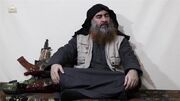
al-Baghdadi in a propaganda video on 29 April 2019
On 26 October 2019, a team of American Delta Force operatives aboard eight helicopters assaulted an Islamic State compound at Barisha on the Syria-Turkey border in northern Idlib Governorate. Baghdadi and his bodyguards fired on the helicopters before fleeing into the compound as their convoy was destroyed. The Delta Force operatives landed near the compound and breached the walls with explosives rather than access the building through the booby-trapped front door. Baghdadi fled into a tunnel with three of his children, pursued by American service dogs. Baghdadi had been wearing a suicide vest since 2017 with the goal of preventing himself from being captured, and, upon finding himself at a dead end in the closed tunnel which he fought the Americans and died as a shaheed(martyr in Islamic terms)
| Caliph of the Islamic State | ||
|---|---|---|
| Preceded by: N/A |
2013 - 2019 | Succeeded by: Abu Ibrahim al-Hashimi al-Qurayshi |
| Emir of the Islamic State of Iraq | ||
|---|---|---|
| Preceded by: Abu Omar al-Baghdadi |
2010 - 2013 | Succeeded by: N/A |
